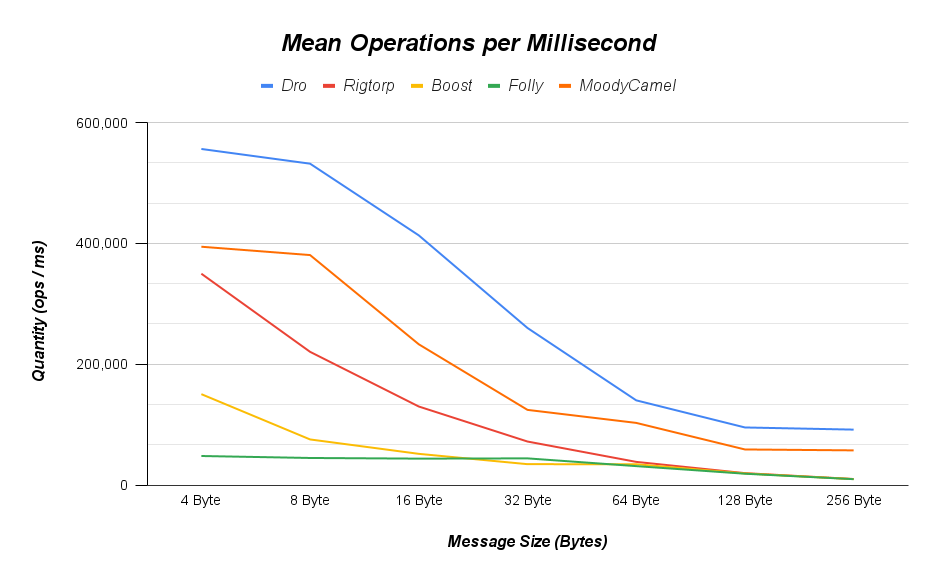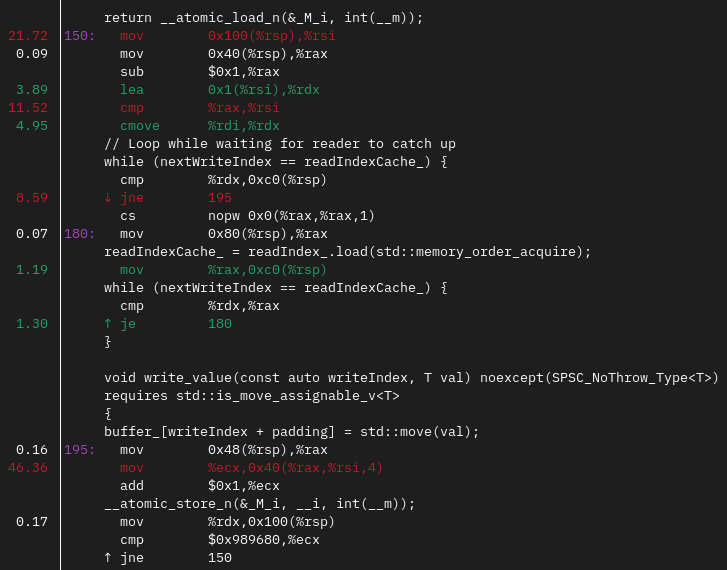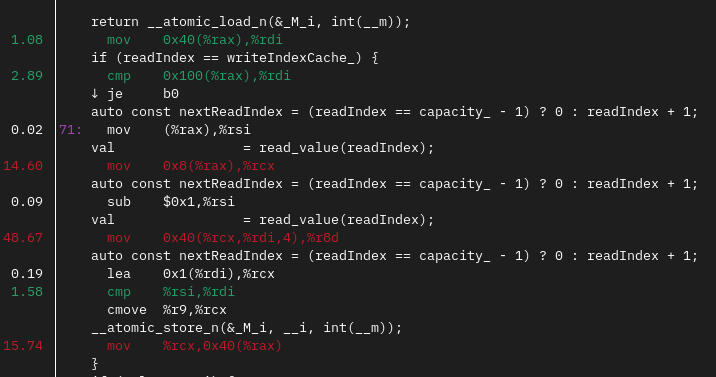A SPSC lock free queue that pre-allocates all memory and transfers messages to and from the queue using copy/move assignment. Achieves a top performance for all message sizes, even higher than MoodyCamel ReaderWriterQueue and Rigtorp SPSCQueue.
The queue uses C++20 concepts to overload the read and write operations, by default all reads and writes are moved into and out of the queue. If the type is non-movable then copy assignment will be used instead.
The full list of template arguments are as follows:
-
Type: Must be default constructible and must be copy or move assignable.
-
std::size_t: The number of object to allocate on the stack, default is 0.
-
Allocator: Allocator to be passed to the vector, takes the type T as the template parameter.
Examples:
// Default Heap Allocation
dro::SPSCQueue<T> queue(size);
// Stack Allocation
dro::SPSCQueue<T, size> queue;
// Custom Allocator on the Heap
dro::SPSCQueue<T, 0, Allocator<T>> queue(size, allocator);Note: Stack allocation size hard coded at 2MBs to prevent stack overflow.
-
explicit SPSCQueue(const std::size_t capacity = 0, const Allocator& allocator = Allocator());Capacity must be a positive number. The default capacity is '0' for a stack allocated queue.
-
void emplace(Args&&... args) noexcept(SPSC_NoThrow_Type<T, Args...>);Constructs type in place, and waits on the reader if the queue is full.
-
void force_emplace(Args&&... args) noexcept(SPSC_NoThrow_Type<T, Args...>);Constructs type in place, and writes over the reader if the queue is full.
Note: If writer surpasses reader, the entire queue will be erased. Use with caution.
-
[[nodiscard]] bool try_emplace(Args&&... args) noexcept(SPSC_NoThrow_Type<T, Args...>);Returns bool, and constructs type in place. Fails to write if the queue is full.
-
void push(const T& val) noexcept(SPSC_NoThrow_Type<T>);Waits on the reader if the queue is full.
-
void force_push(const T& val) noexcept(SPSC_NoThrow_Type<T>);Writes over the reader if the queue is full.
Note: If writer surpasses reader, the entire queue will be erased. Use with caution.
-
[[nodiscard]] bool try_push(const T& val) noexcept(SPSC_NoThrow_Type<T>);Returns bool, and fails to write if the queue is full.
-
void pop(T& val) noexcept(SPSC_NoThrow_Type<T>);Waits on writer if the queue is empty.
-
[[nodiscard]] bool try_pop(T& val) noexcept(SPSC_NoThrow_Type<T>);Returns bool, and fails to read if the queue is empty.
-
[[nodiscard]] std::size_t size() const noexcept;Returns the number of elements in the SPSC queue.
-
[[nodiscard]] bool empty() const noexcept;Checks whether the container is empty.
-
[[nodiscard]] std::size_t capacity() const noexcept;Returns the number of elements that have been allocated.
These benchmarks were taken on a (4) core Intel(R) Core(TM) i5-9300H CPU @ 2.40GHz with isolcpus on cores 2 and 3. The linux kernel is v6.10.11-200.fc40.x86_64 and compiled with gcc version 14.2.1.
Most important aspects of benchmarking:
- Have at least two cores isolated with isolcpus enabled in Grub.
- Compile with -DCMAKE_BUILD_TYPE=Release
- Pass isolated cores ID number as an executable argument i.e. ./SPSC-Queue-Benchmark 2 3
These benchmarks are the average of (11) iterations for a heap allocated queue.
The following is are screenshots from Perf of the main CPU hotspots for each thread. The number one bottleneck is the mov into the queue and out of the queue. The second most time consuming operation is the atomic load and store. This makes sense, as this is the primary work of the SPSC queue.
In the future, I will download the Intel microcode drivers and get a deeper understanding of how exactly the code is executing. Other SPSC queues produce similar assembly code and have different performance characteristics. These differences will likely show up in the microcode analysis.
Push Operation
Pop Operation
Required C++20 or higher.
To build and install the shared library, run the commands below.
$ mkdir build && cd build
$ cmake ..
$ make
$ sudo make install
Inspiration for the SPSC Queue came from the following sources:
This software is distributed under the MIT license. Please read LICENSE for information on the software availability and distribution.

.png)

